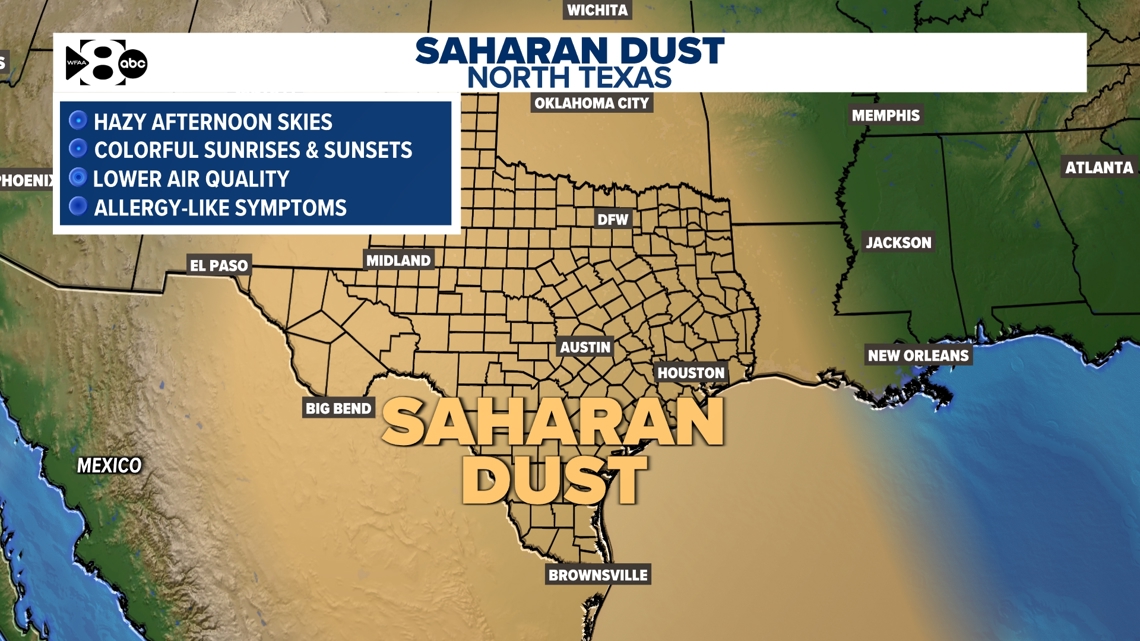Understanding The Saharan Dust: A 5,000-Mile Journey

Welcome to your ultimate source for breaking news, trending updates, and in-depth stories from around the world. Whether it's politics, technology, entertainment, sports, or lifestyle, we bring you real-time updates that keep you informed and ahead of the curve.
Our team works tirelessly to ensure you never miss a moment. From the latest developments in global events to the most talked-about topics on social media, our news platform is designed to deliver accurate and timely information, all in one place.
Stay in the know and join thousands of readers who trust us for reliable, up-to-date content. Explore our expertly curated articles and dive deeper into the stories that matter to you. Visit Best Website now and be part of the conversation. Don't miss out on the headlines that shape our world!
Table of Contents
Understanding the Saharan Dust: A 5,000-Mile Journey
The seemingly endless expanse of the Sahara Desert, the world's largest hot desert, holds a secret: it's a giant, natural dust factory. Every year, colossal plumes of Saharan dust, weighing millions of tons, embark on an epic 5,000-mile journey across the Atlantic Ocean, impacting weather patterns, ecosystems, and even human health on a global scale. Understanding this phenomenon is crucial for predicting climate change and its effects.
The Source: A Vast and Powerful Desert
The Sahara's immense size and arid climate create ideal conditions for dust generation. Strong winds, often associated with weather systems like the African easterly jet stream, lift fine sand and silt particles high into the atmosphere. These particles, composed primarily of clay minerals, quartz, and other materials, form massive dust clouds visible from space. The specific composition of the dust varies depending on the source region, with some areas contributing more iron-rich dust than others. This variation is an active area of research, impacting our understanding of the dust's effects on ecosystems.
The Journey: Across the Atlantic and Beyond
This transatlantic journey is far from a simple straight line. The dust plumes are influenced by atmospheric circulation patterns, altitude, and even the Earth's rotation. They can travel at speeds exceeding 50 mph, reaching heights of several kilometers. The journey's duration varies depending on wind patterns, with some dust reaching the Caribbean and even the Americas within a week, while others take a more meandering route. Scientists use advanced satellite imagery and atmospheric models to track these dust clouds' progress in real-time. [Link to NASA Earth Observatory dust tracking page].
The Impact: A Far-Reaching Influence
The effects of Saharan dust are widespread and multifaceted:
-
Climate Regulation: Saharan dust plays a significant role in regulating global climate. The dust particles reflect incoming solar radiation, having a cooling effect on the planet. Conversely, they can also absorb solar radiation, leading to warming at different altitudes. This complex interaction is a key focus of ongoing climate research.
-
Ocean Fertilization: Iron, a crucial nutrient for marine phytoplankton, is a major component of Saharan dust. When the dust settles into the ocean, it acts as a fertilizer, fueling phytoplankton growth. This, in turn, impacts the marine food web and carbon dioxide absorption by the oceans.
-
Ecosystem Impacts: Dust deposition can affect terrestrial ecosystems, influencing soil fertility and plant growth. However, excessive dust can also have detrimental effects, leading to reduced visibility and air quality issues. Furthermore, dust storms can damage infrastructure and disrupt transportation.
-
Human Health: Saharan dust can pose respiratory health risks, exacerbating conditions like asthma and allergies. Fine dust particles can penetrate deep into the lungs, causing inflammation and other health problems. [Link to a relevant WHO article on air quality and health].
Monitoring and Future Research:
Understanding the intricacies of Saharan dust transport is vital for accurate climate modeling and predictions. Scientists are continuously refining their models using advanced technologies, including satellite observations and computational fluid dynamics. This research helps us better understand the impacts of dust on various ecosystems and human health, enabling the development of strategies to mitigate potential risks and leverage the beneficial aspects of this natural phenomenon.
Call to Action: Stay informed about the latest research on Saharan dust and its impact on the environment and human health. Support initiatives focused on improving air quality and understanding climate change. By staying informed, we can all contribute to a better understanding of this fascinating and significant natural process.

Thank you for visiting our website, your trusted source for the latest updates and in-depth coverage on Understanding The Saharan Dust: A 5,000-Mile Journey. We're committed to keeping you informed with timely and accurate information to meet your curiosity and needs.
If you have any questions, suggestions, or feedback, we'd love to hear from you. Your insights are valuable to us and help us improve to serve you better. Feel free to reach out through our contact page.
Don't forget to bookmark our website and check back regularly for the latest headlines and trending topics. See you next time, and thank you for being part of our growing community!
Featured Posts
-
 Former Junior Athletes Triumphant Return Day 4 Highlights
May 31, 2025
Former Junior Athletes Triumphant Return Day 4 Highlights
May 31, 2025 -
 Western Conference Semifinals Concludes Thunders Triumph Over Wolves Sends Them To Nba Finals
May 31, 2025
Western Conference Semifinals Concludes Thunders Triumph Over Wolves Sends Them To Nba Finals
May 31, 2025 -
 Ongoing Search For Missing Lexington Teen Police Release Updated Information
May 31, 2025
Ongoing Search For Missing Lexington Teen Police Release Updated Information
May 31, 2025 -
 Convicted Republicans Receive Pardons From Trump A Growing List
May 31, 2025
Convicted Republicans Receive Pardons From Trump A Growing List
May 31, 2025 -
 Capitals Ovechkin Remains Silent On Retirement Following Email Controversy
May 31, 2025
Capitals Ovechkin Remains Silent On Retirement Following Email Controversy
May 31, 2025
